 Categories
Categories

 Products By Price
Products By Price

 Information
Information

|
Education
Knowledge of 4C
 
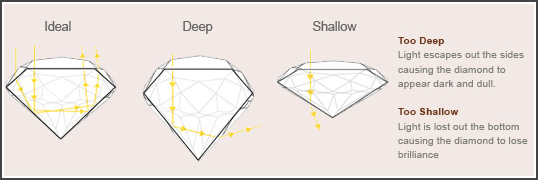 |
Cut
How well does your diamond dance in the light? The answer lies in how it is cut. Cut is arguably the most crucial of the 4Cs when it comes to fire, sparkle and brilliance; it refers to the diamond’s proportions (how the diamond's angles and facets relate to one another), symmetry (the precision of its cut) and polish (the condition of your diamond's surface). Cut is also associated with the shape of your diamond.
All diamonds have five basic components. The table is the uppermost facet, or the flat surface on the top of the diamond. The crown is the section of facets between the table and the midsection of the diamond. The girdle is the horizontal midsection and widest part of the diamond. The pavilion is the section of facets between the girdle and the bottom tip of the diamond. The culet is the bottom tip of the stone. A traditional round brilliant diamond consists of 58 facets, 33 in the crown and 25 in the pavilion.
In a well-proportioned and symmetrical diamond, light will enter and exit through the crown to the eye. A poorly cut diamond, however, allows too much light to escape through the sides and bottom. As a result, a diamond with a poor cut will appear dull, even if it has good color and clarity.
Most diamonds are cut in three basic styles: Brilliant-cut diamonds include round, oval, pear, heart, and marquise-cut diamonds. Step-cut diamonds feature rows of facets positioned in a step-like fashion. Most step-cut diamonds have four sides and a rectangular shape, such as emerald-cut and baguette. Mixed-cut diamonds combine the qualities of the brilliant and step-cuts. The most popular is the princess-cut (or radiant-cut) Choosing a shape is truly a matter of personal style, although there are some basic guidelines:
Round Brilliant-cut: For those who are traditional by nature. Round is by far the most popular shape. Its design has been developed over the last hundred years. The round brilliant-cut best features a diamond's fire, sparkle and brilliance. For those who favor contemporary style, princess-cut diamonds are a good choice. Princess-cut diamonds are quickly gaining in popularity. Marquise diamonds are especially flattering for women with slender fingers. Heart-shaped diamonds are a truly romantic and unique choice. Emerald-cut diamonds are excellent for women whose taste runs more to the classic. Pear-shaped cut (or teardrop) offers a unique way to express yourself. Oval-shaped diamonds have an original beauty and are preferred for women who want to break with tradition.
|
 
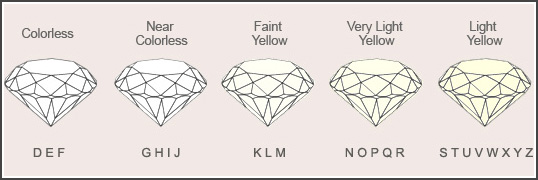 |
Color
The body color of a diamond can range from colorless to yellow. The scale for determining a diamond’s color was developed by the Gemological Institute of America (GIA). Color is largely a matter of preference. Their breathtaking purity and radiance make colorless diamonds a must for some people. Others have a preference for slightly yellow diamonds and a warmer look.
A diamond’s color is determined by its chemistry. While a diamond is made up of pure carbon, other natural elements may have been incorporated into the carbon during the diamond’s development. This causes a chemical reaction that changes the color of the diamond. For example, small amounts of nitrogen cause yellow diamonds, while blue diamonds are caused by boron.
Diamonds never change color over the years. However, a diamond’s setting can often influence its appearance. A yellow diamond will appear whiter in a yellow gold setting, while platinum and white gold settings may make the yellow color more apparent. In the same fashion, a colorless diamond set in yellow gold may reflect the setting's yellow tint.
On the color scale, there is a category of "fancy" color diamonds that fall into the range of “Z+”. These gems are very unusual and therefore highly prized. Colors include yellow, violet, orange, blue, pink and red (the most rare). Among the most famous fancy color diamonds is The Hope Diamond, displayed in the Smithsonian Institution in Washington, D.C. Although, at 45.52 carats, it is not the largest diamond, the Hope Diamond is admired for its dark blue hue.
|
 
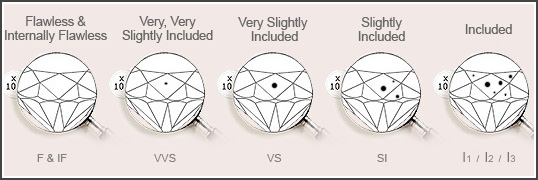 |
Clarity
Clarity is the measure of a diamond's flawlessness. When light is able to pass through a diamond uninterrupted, the result is a beautiful sparkle.
Nearly all diamonds have tiny imperfections known as "blemishes" (externally) or "inclusions" (internally). This is not surprising, considering the journey that diamonds have taken during their lifetime. Over a billion years ago, diamonds formed in the mantle of the earth. During this time, trace elements often became trapped inside, lending a unique personality to the diamond's appearance.
Even diamonds with inclusions and blemishes can be among the most beautiful, especially those with good color and cut. Many inclusions are difficult to see with the naked eye, and some may be minimized by the setting you choose.
Experts measure clarity with special equipment. A classic jewelers' tool is the loupe, a small 10-power (10x) magnifying glass. This is the standard magnification when determining diamond clarity. Jewelers will also use gemological microscopes to show you the characteristics of your diamond.
|
 
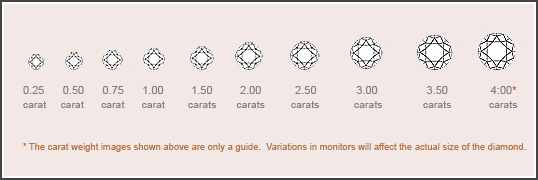 |
Carat Weight
Diamonds are measured in "carats." The carat is the weight of the diamond and is evaluated on a point system. 100 points equals one carat; 50 points equals one-half carat, etc. To think of it another way, one carat equals 200 milligrams, and 142 carats equals one ounce.
"Carat" is not the same as "karat," the unit that measures the purity of gold. The term "carat" comes from the carob seed, a unit of measure for diamond weight that dates back to ancient times. As technology improved, jewelers started using mechanical balances and electric scales to ensure accurate carat weight measurements. Most diamonds today are weighed using electronic gem scales.
As you would imagine, larger diamonds are found in nature less often than smaller diamonds and are therefore more costly. A one carat diamond costs far more than two one-half carat diamonds (provided they are equal in terms of cut, color and clarity).
You will want to take several factors into account when choosing the right carat weight for you. Diamonds on small hands appear larger. And the setting you choose can make a difference in the diamond's appearance.
Did you know…the Cullinan Diamond is the largest ever discovered, weighing in at 3,106.75 carats (the equivalent of 1 1/3 pounds). It was mined in 1905 in South America and was then cut into several smaller diamonds. Some of the pieces from the Cullinan may be found in the British Crown Jewels.
|
  Jewelry Care
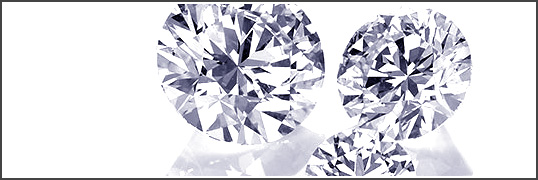 |
Diamond Care
While a diamond is the hardest mineral known to man, it still requires special care. Regular cleanings are a must to maintain a diamond's brilliance. A solution of half-ammonia and half-cold water works just fine. Let your diamond soak for 30 minutes, then dry it with a lint-free cloth. There are those who say you can place your diamond in a glass of vodka to restore its sparkle. Everyday activity can be pretty rough on your jewelry, so be sure to have it checked every six months to ensure your diamonds are secure in their settings.
Metal Care
Different metals can require very different levels of care. While both tungsten and platinum are very durable, for example, tungsten needs little attention, while platinum is susceptible to scratches. It is recommended you have your platinum buffed every six months. You can remove build-up with jewelry cleaner or mild soap and water. And regular polishing can keep your silver from looking tarnished. Silver jewelry from Jared is sterling silver, which is damaged less easily than regular silver. Gold is another metal that needs gentle care. Soap film easily builds on the surface of gold, so it's best to remove your gold jewelry before showering or using household cleaners or chemicals. Chlorine has also been known weaken gold, causing it to break more easily. Placing your gold jewelry in a solution containing a few drops of ammonia, mild detergent and warm water will bring back its shine. Rubbing alcohol can also be used to remove grease and body oil from gold jewelry.
Cultured Pearl Care
Cultured pearls are especially soft and vulnerable. They should be the last item you put on and the first item you take off. Makeup, hair spray, perfume and other chemicals are very harmful to cultured pearls. It's a good idea to wipe them with a clean, damp cloth after each use to remove build-up, dirt and oil. Also, make sure your cultured pearls are completely dry before putting them away. Hot water, steam, extreme temperatures and ultrasonic cleaners should be avoided as well. Upon inspection, some jewelers may also recommend restringing your cultured pearls.
|
|
|